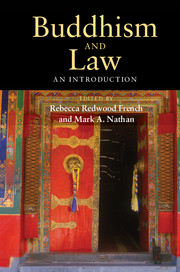Book contents
- Frontmatter
- Dedication
- Contents
- Maps and Illustrations
- Contributors
- Preface
- Abbreviations
- Introducing Buddhism and Law
- Part I The Roots of Buddhism and Law in India
- Part II Buddhism and Law in South and Southeast Asia
- Part III Buddhism and Law in East Asia
- Part IV Buddhism and Law in North Asia and the Himalayan Region
- 17 Buddhism and Law in Tibet
- 18 Buddhist Laws in Mongolia
- 19 Karma, Monastic Law, and Gender Justice
- 20 Buddhism and Constitutions in Bhutan
- A Selection of Readings
- Index
- References
20 - Buddhism and Constitutions in Bhutan
Published online by Cambridge University Press: 05 August 2014
- Frontmatter
- Dedication
- Contents
- Maps and Illustrations
- Contributors
- Preface
- Abbreviations
- Introducing Buddhism and Law
- Part I The Roots of Buddhism and Law in India
- Part II Buddhism and Law in South and Southeast Asia
- Part III Buddhism and Law in East Asia
- Part IV Buddhism and Law in North Asia and the Himalayan Region
- 17 Buddhism and Law in Tibet
- 18 Buddhist Laws in Mongolia
- 19 Karma, Monastic Law, and Gender Justice
- 20 Buddhism and Constitutions in Bhutan
- A Selection of Readings
- Index
- References
Summary
Introduction
The subject of Buddhism and constitutionalism, or more specifically constitutions, presents us with a series of questions and challenges. As the other essays in this volume demonstrate, Buddhism adapted itself to the local cultures and polities it encountered as it spread to the north and east from India. So what we mean or understand by the term “Buddhism” is problematic when generalized across South, Southeast, Central, and East Asia. Equally, how are we to define “constitution”? Are we looking for a written constitution, such as in Thailand, or one based on custom and rules that constitute, as in the United Kingdom, an unwritten constitution? We generally understand constitutions as enabling people – citizens – to act and participate in a political system by defining how they can participate and how decisions are made. Typically, constitutions set out laws that are constitutive and laws that are regulative in nature. I understand constitutions as defining the basic powers of a government, and their limits, and the relationship between a government and its citizens, while recognizing that the term “constitution” has no equivalent in Tibet or Bhutan prior to the creation of written constitutions in the second half of the twentieth century.
This chapter will focus on Bhutan, a small landlocked kingdom located in the eastern Himalaya that has sought to balance its traditional values informed by Buddhist teachings with major political and social change. The interrelationship between Buddhism and constitutions has been particularly significant in Bhutan, which moved from an unwritten constitution to a written constitution on July 18, 2008. Central to the constitution enacted in July 2008 are the concepts of a Buddhist monarchy and Gross National Happiness (GNH). For the first time since the unification of Bhutan in the seventeenth century CE, the state-sponsored Central Monk Body has been excluded from the legislature. Moreover, the constitution takes care not to declare Buddhism the official religion of Bhutan. In this, Bhutan mirrors other Buddhist nations, for example, Thailand.
- Type
- Chapter
- Information
- Buddhism and LawAn Introduction, pp. 350 - 368Publisher: Cambridge University PressPrint publication year: 2014
References
- 3
- Cited by

